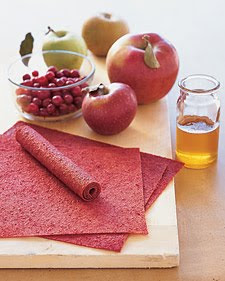Our task for today is to make a fruit leather, well what we understand about fruit leather is that it is healthy snacks that have high vitamins. Because the food is processed directly and the contain of vitamin is still available. These can be eaten as snack of maybe can be served as breakfast.
Basic Formula Fruit Leather
Recipe:
=Strawberry,hulled and cut half 2 1/2cup
=Sugar 25g
Method:
- Puree strawberry in blender until smooth. Stir in sugar.
- Line jelly roll pan with aluminium foil and fasten it to the edge with masking tape.
- Spread the fruit evenly in the pan. Dry in oven at 60C until completely dry and no longer sticky, approximately for 12 hour bake in the oven.
- Remove from aluminium foil and roll up. Wrap the roll tighly in aluminium foil and store at room temperature in a tightly closed plastic bag or container. (Note: Apple leather can be made using 1 1/2cup of apples(peeled, cored and puree), 90ml water, 75g sugar and 0.8g cinnamon).
- Control-Prepare the basic formula.
- Honey, 60C oven_prepare basic formula but subtitute honey 30ml instead of using sugar.



Next, is to blend the items prepared earlier into a puree. We start by adding strawberry, followed by sugar and then, blend it until fine.



In the mean time, we continue the blending process which will be using honey. Start adding strawberry followed by the honey and lastly blend it to puree.



Baking starts at 9:30am.
At 12:00pm, the strawberry has started to dry at the side.
At last, the first one is done. Which is the honey strawberry leather. The time it was ready was at 12:50pm.
And it's time for the evaluation. By judging at the look, it looks darker pinkish and by tasting it, it have a sweet taste at first and slowly the taste of bitter. As for the tenderness, it is very chewy and the texture is kind of dry.
Next, is the sugar leather strawberry. It dried completely at 1:00pm.
Well for the sugar strawberry leather it look dark pink and when come to taste, the taste is sweet and there is a light taste of sour. The tenderness is chewy and the texture of it is dry as well.



After all the long wait we can see the achievements we had done. Well from all the fruits we used, we think peach taste better then other fruits. As we learn for today is different fruits has different content of water. As for example you can see apple takes the longest time to dry. Also we learn that using honey and sugar have a slide changes. Which you can see that honey help to make the fruits shine but, it will make the taste to turn bitter as well. For sugar it makes the taste better but it is not so appealing and shiny as honey. In the end, we gained new knowledge by using different kind of fruits will cause different effect.


















































